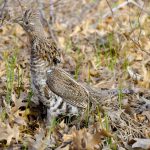by Dave Smith
This update to our 2018 Upland Gamebird Hunting Forecast incorporates the results of late summer upland bird population surveys. This final piece of data measures recruitment of birds into the fall population, allowing us to provide a more finely tuned forecast than was possible at press time for the print magazine in mid-July.
Forecasting fall populations of pheasants, bobwhites, prairie grouse, desert quail, and chukars is a mix of science and art, informed by surveys of gamebird populations at the beginning of the breeding season, spring-summer weather patterns, and, in some states, late summer roadside or brood surveys that estimate the current year’s production.
Many state fish and wildlife agencies conduct surveys each spring that provide an index of populations. Pheasant crowing counts, bobwhite whistle surveys, and grouse drumming or lek counts provide an indication of bird numbers coming in to the breeding season, a measure of over-winter survival and the previous year’s production. This is good trend data but doesn’t tell much of the current year’s story since the reproductive potential of most upland game species is extremely high and populations fluctuate wildly from year to year based on nest success and brood survival.
By mid-summer, weather patterns and anecdotal observations are often enough to enable accurate projections of the level of production during the current breeding season. State fish and wildlife agencies upland game specialists have a ton of experience in correlating weather patterns with upland game populations, and often get it right. This is the basis of our annual print version PDJ Upland Gamebird Hunting Forecast.
The last piece of data, which can cement or change our forecast, are the results of summer roadside or brood surveys conducted by some state fish and wildlife agencies. Here’s a look at this data relative to 2018 upland game populations. In most states, the encouraging mid-summer projections held up nicely, and it’s going to be a pretty good year to chase upland gamebirds!
PHEASANTS
South Dakota’s roadside surveys revealed a 47 percent increase over last year, up to 2.47 pheasants per mile surveyed, a function of good moisture and excellent habitat conditions following the epic drought of 2017 that torpedoed pheasant production across much of the state. The highest densities of pheasants were in the Chamberlain (5.29 pheasants per mile), Mitchell (4.23), Pierre (3.72), and Huron (3.61) areas, all of which increased from last year, led by a 95-percent spike in the Huron area. The harvest this season should exceed 900,000 pheasants. Kelly Hepler, South Dakota Game, Fish & Parks Secretary, was enthusiastic: “A substantial increase in the pheasants per-mile index is an exciting prospect for South Dakota’s 100th pheasant hunting season this fall.”
In Iowa, the statewide index of 20.6 birds/route is significantly higher than the 2017 estimate of 14.9 birds/route and 45 percent above the 10-year average. The highest counts were in the Central and Northwest regions, but production was also excellent in all three of the southern regions. The Central region surveys revealed 38.6 birds/route, 85 percent above the 10-year average and right at the long-term average. Good bets include Boone, Hamilton, Hardin, Poweshiek, Story, and Webster counties. The Iowa Department of Natural Resources predicts a harvest of up to 300,000 pheasants this season.
In Minnesota, despite severe spring snowstorms and excessive rainfall, this year’s range-wide pheasant index (45.5 birds/100 mi) increased 19 percent from 2017, and is similar to the 10-year average. The index varied statewide with 95 percent and 51 percent increases in the Central and West-Central regions, respectively, contrasted by a 36-percent decline in the Southeast region and a modest five-percent uptick in the Southwest region, the core of the pheasant range. The highest counts (65.1 birds/100 mi) were observed in the West-Central region. Good hunting is expected in the West-Central, Southwest, and Central regions.
Nebraska’s pheasant population is stable with the statewide population just one percent below the five-year average. Pheasant populations in the Sandhills increased by 78 percent and now are 30 percent above the 2013-2017 average! In the Panhandle, pheasant numbers dropped 39 percent from last year but are still 31 percent above the five-year average. The best hunting is expected to be in the Panhandle, Southwest, and Sandhills.
In Kansas, heavy spring rains and hail storms impacted nest success and brood survival, resulting in a significant pheasant decline, and this summer’s roadside surveys indicate a below-average pheasant population. However, keeping things in perspective, Kansas will likely remain one of the top states for pheasant harvest! The best bets this fall will be north-central and south-central Kansas.
It will be a tough year in North Dakota where the statewide survey revealed a two-percent decline in pheasant numbers. That only tells part of the story, though: Pheasant populations declined by 32 percent from last year in the Southwest region, the heart of North Dakota’s pheasant range. Populations increased by 63 percent and by nine percent in the Southeast and Northwest regions, respectively, but those regions were coming into the spring with very low populations. Harvest is expected to be similar to that of the drought-stricken 2017 campaign when hunters took 309,000 roosters.
BOBWHITE QUAIL
Iowa is still riding the crest of a modern-era bobwhite boom. The last four years represent the highest quail indices in the last 20 years, and this year was even better! The bobwhite quail index was 1.36 birds/route, a significant increase from last year and 62 percent above the 10-year average. In Kansas, heavy summer rains contributed to declining quail populations in most regions, but good quail populations still exist in central Kansas extending east into the Flint Hills. The south-central prairies exhibit excellent intermixing of quail cover, and some of the field reports indicate quail reproduction may have been better than indicated by the August roadside surveys. Likewise, the Smoky Hills of north-central Kansas will offer some good bobwhite hunting. In Nebraska, quail numbers declined by 28 percent statewide, but the quail population is still four percent above the five-year average. In relation to the five-year averages, quail numbers are strong in the Republican (+22 percent), Southeast (+21 percent), and East-Central (+89 percent) regions.
SHAPTAILS, HUNS, AND PRAIRIE CHICKENS
Prairie grouse hunters that normally focus on the northern Great Plains might consider shifting southward to Nebraska and Kansas this year. In Nebraska, sharp-tailed grouse and greater prairie chicken numbers were up in the Sandhills and Central regions, the portions of the state that offer the best prairie grouse hunting. Habitat conditions in the Sandhills were spectacular with abundant vegetation and lots of insects for good nesting and brood survival. Likewise, greater prairie chicken populations are stable to increasing in the Smoky Hills and Northern High Plains regions of Kansas.
The bad news comes from the heart of prairie grouse country – the Dakotas and Montana – where sharptail population levels are depressed due to the lingering effects of the horrendous 2017 drought. In North Dakota, this summer’s roadside surveys showed a 49-percent decline in statewide grouse numbers from last year. In Montana, lek counts were 25-40 percent below the long-term average and summer moisture was spotty, so numbers are expected to be low again this fall. However, South Dakota should see an uptick due to excellent moisture and habitat conditions across the northern and central regions. This year will be average at best, coming off a tough season when hunters harvested 22,153 prairie grouse, less than half of the roughly 50,000 taken in 2015.
The outlook for Huns is best on the western edge of their range. Biologists in eastern Oregon and southwest Idaho were giddy about the partridge production, even in some areas that are generally marginal for Huns!
CHUKARS
The Great Basin is characterized by highly dynamic weather patterns, and chukars are a prolific gamebird that can reproduce at dizzying levels when conditions are right. These two truths lead to boom-and-bust patterns in chukar populations. That’s why most seasoned chukar hunters live by a simple ethic: Go where the getting is good. In 2018, chukar production was outstanding – at a minimum – in eastern Oregon and southwest Idaho, and this season may offer some of the best chukar hunting in years!
Surveys in Malheur County of southeastern Oregon revealed 47 chukars per 10 miles, a 48 percent increase from last year and 15 percent above the 10-year average. Brood size was way up with 11.6 chukars observed per brood, indicative of a great hatch and lots of young birds. The most productive routes were along the west side of the Owyhee Reservoir and Cottonwood Canyon southwest of Harper. Mikal Cline, Oregon Department of Fish and Wildlife Upland Game Bird Coordinator, sums it up succinctly: “This would be an excellent year to take to the field in eastern Oregon for chukar, quail, and partridge.”
It’s a similar story in adjoining western Idaho where chukar populations are expected to be excellent due to a mild winter and near-perfect timing of abundant spring rains! In the Southwest Region, good-sized chukar broods were reported near the Bruneau and East Fork Owyhee Rivers, and in the hills above Emmett. Andrus WMA, Owyhee Front, South Fork Boise River, and Owyhee Canyonlands are all expected to offer good chukar hunting this season. In the Clearwater Region, field observations are even more encouraging with lots of birds and numerous large broods.
Nevada is still an unknown at this juncture because the chukar survey data isn’t yet available. However, early reports were very promising for north-central and northeastern Nevada due to abundant rainfall in May which set the table for excellent chukar production. Look for the Nevada Chukar Forecast in the next couple of weeks at http://www.ndow.org/Hunt/Seasons_and_Regulations/Upland_Game/.





